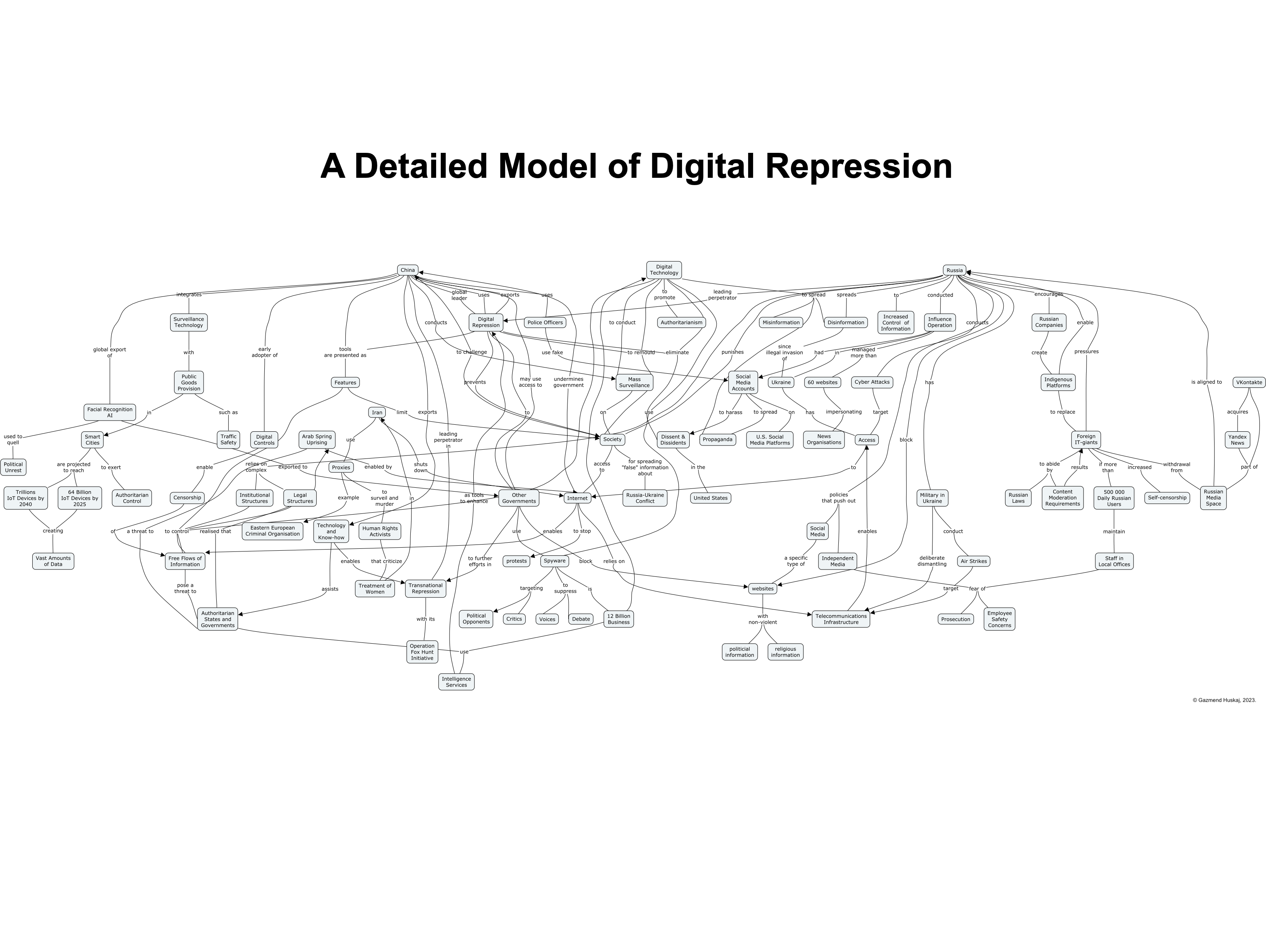Digital Authoritarianism: A Summary

On 24 April 2023, The US Director of National Intelligence (DNI) Dr. Avril Haines was invited to a public conversation with Carnegie’s Dan Baer on combatting digital authoritarianism. This is a summary of her presentation. The entire presentation including the Q&A session is on Carnegie Endowment’s YouTube-page.
Today, democracy is increasingly challenged by autocratic leaders that contest over information, defined as “the increasing use of digital technology to promote authoritarianism.” The DNI highlighted the importance of intellectual exchange between the intelligence community and think tanks like Carnegie Endowment to “challenge our thinking and work to ensure that we are focused on what matters, and not missing the broader strategic pictures.” This collaboration is especially fruitful in understanding the landscape, addressing the problem, and focus in one aspect of a problem.
The aspect the DNI was commenting was “the degree to which new technologies, institutional, legal, and organisational approaches to digital repression being deployed by authoritarian governments and exported to other countries are advancing authoritarianism and undermining democratic governance globally.”
The DNI covered seven themes in her presentation. First, the distinction between an intelligence service in a democracy versus an authoritarian state. Second, why digital repression is a critical threat to national security. Third, how foreign governments are “increasingly using digital information and communication technologies to monitor and suppress political debate domestically as well as in their expat and diaspora communities abroad.” Fourth, describing the Russian, Chinese and Iranian models and methods “that are being exported.” Fifth, how governments are increasingly using spyware to “target political opponents and critics.” Sixth, how governments are using technologies to limit user access to information. Finally, the DNI describes how the intelligence community “alongside the private sector and research institutions can help to create greater awareness regarding the types of technologies as well as the institutional legal and organisational approaches being used to engage in digital repression.”
Intelligence services in democracies vs. an authoritarian State
According to the DNI, Intelligence services in democracies: “are subject to democratically passed laws, have internal and external safeguards in place and ultimately are held accountable to oversight mechanisms that work to ensure we remain legal, ethical, and focused on providing the best intelligence to help decision makers in our government make better national security and foreign policy decisions while being protective of people’s civil liberties and privacy.”
In authoritarian countries, intelligence services are “often used as tools of the state to enhance digital repression under the direction of their rulers.”
Why is Digital Repression a Critical Threat to National Security? Authoritarian States are increasingly using digital technology to promote authoritarianism. Free flows of information pose a threat and authoritarian countries were early concerned with the Internet and the implications of free flows of information. The Arab Spring uprising “served as a turning point when authoritarian governments came to recognise that their public’s digital connectivity posed an existential threat to their grip on power.” Therefore, using digital technologies to control the flows of information, eliminate dissent, remould society, conduct mass surveillance, spread disinformation, misinformation, and propaganda, and use spyware to suppress voices and debate, authoritarian States are exporting authoritarianism which is a risk to the integrity of democracy and democratic societies.
China
The People’s Republic of China (PRC) is a “global leader in digital repression”, topping Freedom House’s list of countries with the least internet freedom for eight consecutive years. China excels at censoring digital information and surveilling its population due to early prioritization of digital controls. The PRC uses digital repression to prevent challenges to its rule, eliminate dissent, and reshape society for national rejuvenation.
China presents its use of digital repression tools as features, controlling information flow and limiting citizen access to information that may undermine the government’s legitimacy. The country exports its technology and know-how, enabling transnational repression and assisting other governments in digital repression within their borders.
Chinese smart cities integrate surveillance technology with public goods provision, such as traffic safety, to exert authoritarian control. The PRC is also the leading perpetrator of transnational repression, often through digital means, with its Operation Fox Hunt initiative. Recently, the EU’s Department of Justice charged PRC police officers for using fake social media accounts to spread propaganda and harass dissidents in the United States.
Russia
Russia is also a leading perpetrator of digital repression, taking a different approach from China by relying on complex legal and institutional structures to control information. It has been particularly active in spreading disinformation since the start of Putin’s illegal invasion of Ukraine. Internet freedom in Russia is the 6th least free globally and reached an all-time low last year.
The Kremlin has blocked social media sites and thousands of websites and introduced harsh penalties for spreading “false” information about the Russia-Ukraine conflict. Moscow has pressured foreign IT giants to abide by its content moderation requirements, resulting in increased self-censorship and withdrawal from the Russian media space. The expansion of Kremlin-aligned media corporations, such as VKontakte’s acquisition of Yandex, has given the government greater control over online content.
In 2022, Moscow required foreign IT and media companies with significant Russian user bases to maintain local offices and comply with Russian laws. The government has encouraged the development of indigenous platforms to replace foreign social media companies, allowing for increased content control. Russia has also undermined internet freedom in Ukraine through internet shutdowns, cyberattacks, targeted airstrikes, and dismantling of telecommunications infrastructure.
A Russia-based influence operation in Ukraine was discovered last September, involving over 60 websites impersonating news organizations and accounts on major U.S. social media platforms.
Iran
Iran imposes Internet shutdowns to stop protests, such as during the protests after the death of 22-year-old Mahsa Amini in police custody. During the protests, Iran conducted 18 Internet shutdowns. Furthermore, Iran has presented its intent and capability to use proxies such as an Eastern European criminal organisation to suppress dissidents by murdering them: a human rights activist was murdered after criticizing Iran’s treatment of women.
Other Tactics Techniques and Procedures (TTPs)
Other countries are adopting the approaches mentioned for digital repression. Additional tactics include the tactic of internet shutdowns, blocking websites, using commercial spyware, to provide only access “to an online space that mirrors the views of their government and its interests”, limiting “users access to information sources located outside of their borders”, monitoring populations and “potentially manipulate control and exploit information based on the insights gained from the” vast amounts of data created by billions and trillions of internet of things-devices connected to smart city initiatives, and exploiting facial recognition AI to quell political unrest.
The Response to Digital Repression
Collaboration between the intelligence community, private sector, and research institutions is crucial. Raising awareness about technologies and approaches used for digital repression, we can help develop normative frameworks that preserve the positive potential for these technologies while guarding against their repressive uses. This should include promoting technical standards and design approaches that support cybersecurity, democratic governance, freedom of expression, and political discourse, while acknowledging the risks associated with vast data collection. In addition, modern laws and organizational structures are needed to make digital repression more difficult. As certain governments become more adept at using repressive technologies, urgent action is required to address the growing sophistication of automated surveillance and identity resolution techniques.
Digital repression and foreign malign influence are whole-of-society challenges that require a unified response to protect the integrity of democratic societies worldwide.
A Detailed Model of Digital Repression
This section presents a detailed model of digital repression based on the presentation.

Due to China being an earlier adopter of Digital Controls, it is more mature in controlling information flows. Russia, on the other hand, is working to get there. Finally, Iran will likely need a higher level of maturity in digital controls and therefore currently relies on simply shutting down their portion of the internet combined with deterrence by punishment and fear manifesting in for example, crackdowns.